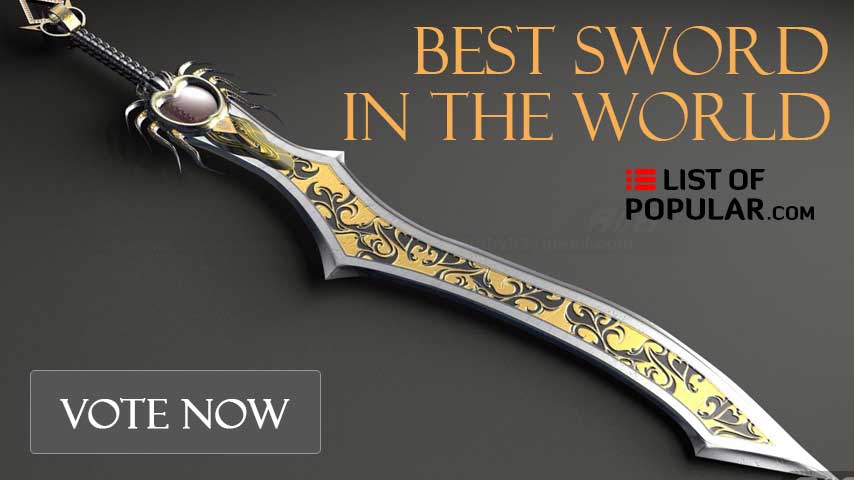1. Zulfiqar
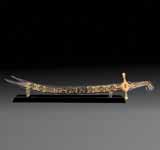
Dhū l-faqār, also Zulfiqar or Zulfikar, was the name of a sword of Ali ibn Abi Talib, which he received at the Battle of Badr from Mohammed as prey. After it had come into possession of his son, it became an important symbol of the Shiites, Alevis and Alawites. The name of the sword has been attested since the late 8th century. In the past, the sword was often depicted as a double-edged sword similar to scissors on Muslim flags, and is commonly displayed in Shi'ite portrayals of Ali and in the form of jewelry used as talismans. Middle Eastern weapons generally include quotations mentioning Zulfikar, and Middle Eastern swords made several times with the tip divided in reference to the weapon.
2. Katana
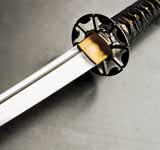
The katana ("Japanese sword" also known as Shinken "real sword") or catana is a "sort of scimitar of origin Japanese" according to the RAE, although in the West the word is used generically to encompass all sables. Japanese Katana is the kun'yomi or Japanese reading of the kanji?. The on'yomi or Chinese reading is to. It refers to a particular type of single-edged sword, curved, traditionally used by samurai. The most widespread type of katana today is known as "Oda Nobunaga", alluding to the daimyo creator of this model, curved blade and about a meter in total length. Traditionally, Japanese sword blades are made of Tamahagane. They are manufactured in an almost unique way in a sophisticated process.
3. Kaskara
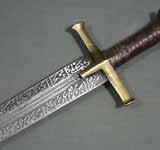
The Kaskara is a sword that occurs mainly in Sudan and adjacent areas. The origins of Kaskara date back to the 8th century, the period of Islamic expansion. The Kaskara has lost the function as a weapon. In this region, however, it belongs to the lived tradition. The Kaskara has a straight, double-edged blade. In some Kaskaras the blade tapers slightly towards the tip, in others the sides run parallel and only form a point at the end. The blades have different types of fillets. There are variants with a wide or several narrow grooves. Most blades come from European production, few are of native origin. New blades of the 20th century were forged locally, for example from old leaf springs of automobiles. They are superior to the early natives who broke in combat, but they do not match the quality of the previously imported blades.
4. Khopesh
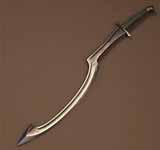
A khopesh, kefresh or jepesh is a sword or saber curved blade in the form of "U" or sickle - shaped (depending on the period) with the edge in its convex part, used in the ancient Middle East and the Canaan area and it became popular in Ancient Egypt. The jepesh owes its name to its resemblance with the leg of a bovid. In the representations of offerings in temples, in terms of meat, the right front leg form of a bovid (jepesh) was the most relevant. Its origins can be traced to the Sumer of the third millennium. According to historians and archaeologists, the khopesh was introduced by the Canaanites (Semitic people who settled in the Middle East) after the wars they fought with Egypt, but there is no more data.
5. Changdao
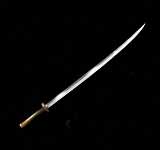
Changdao was a type of anti-cavalry sword used in China during the Ming dynasty. Sometimes it was called Miao dao, its blade closely resembles a Japanese ōdachi. This weapon was adopted by General Qi Jiguang, who acquired a manual of the Kage-Ryu, received by Japanese pirates (wokou), where he studied and modified it for his troops, using it against the enemies on the Mongolian border in 1560. He replaced the zhǎnmǎdāo as a weapon to "unhook horses". At the time of General Qi it had a length of 1.95 meters, similar to the Japanese ōdachi. Its handle is long, it seems, a little more than a third of its total length, and its curve is deeper than that of Japanese swords. Commanding up to 100,000 soldiers at the Mongolian border, General Qi saw the effectiveness of the weapon, to the point that 40% of his troops owned a changdao.
6. Panabas
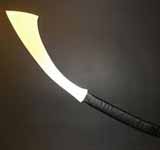
The Panabas has a long, curved or kinked blade. The blade does not have a hollow cut (falsely blood groove) and no middle ridge. It is bent along its entire length or has an upward crease shortly after the handle. The point is oblique or straight (cut off), but in some also long, pointed outlet. In the models with the beveled tips, there is an upwardly pointing spine on the slope, just like the Kampilan, The blade is about 50 cm long. The total length is about 80 cm. The booklet is usually made of wood and is reinforced with brass and/or copper rings. The knob consists of a metal plate that closes the handle. There are different versions.
7. Shamshir

The shamsir is the alfanje or Persian saber par excellence, with a curved leaf and a cross of short hawks, its stylized leaf curves regularly from its first third. Of a single edge by norm, except in its last section -to puncture-, it was a weapon of a single hand. In Europe, it seems that the term derived in "scimitar", or so at least many sources assure. That is why it would be the native scimitar voice: the shamsir of the East. Shamsir comes from Persian and means: "curve like the lion's claw". The shamsir are a variant of the Turkish-oriental alfanjes that from the Mongol invasions and their later Balkan developments ended up being the traditional Arab scimitars that everyone knows, and that, later, in the 13th century imported the Chinese empire, given its immense quality and effectiveness, to India, China, Pakistan etc.
8. Balisword

9. Liuyedao
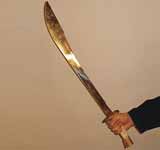
Liuyedao is a Chinese martial art knife that is used because of the shape of the willow like a knife, hence its name Lancet. It is commonly used on cavalry and infantry. Liuyedao the (Yoto Liu), Chinese martial art is used like a sword of China. In terms of classification, it can be said to be the most famous one-handed weapon such as swords, axes, weights, whips, and spears etc., which are called "troopers". A one-handed sword that is curved with a single blade and the width of the blade is very wide compared to Japanese swords. Demonstrates power by cutting weight and centrifugal force.
10. Gladius

11. Falcata

The falcata is a curved-edged sword originally from pre-Roman Iberia. Its use is historically associated with the populations of the southeast of the Iberian Peninsula during the conquest of Hispania, where it constitutes one of the most emblematic native white weapons of antiquity. The Iberians knew the Falcata since the 5th century BC and used them until the beginning of the 1st century AD. The falcata is a short sword, modeled after the Greek Makhaira over their Italic-Adriatic variants. It has a human-adapted handle and an asymmetric, about 50 centimeters long blade. Equipped is the Falcata with double or simple cutting and sharp tip. It was found ornamented Falcatas with silver inlays.
12. Arming sword

13. Yanmaodao

14. Claymore

15. Arab sword

16. Billao

The Billao, also known as Belawa, is a Somali short sword or dagger. The Billao has a double-edged, iron blade and a trapezoidal pommel. The knob is usually made of buffalo horn. The dagger is worn in a sheepskin sheath at the waist with a belt. The Billao is available both as a dagger and as a short sword. The dagger is asymmetrical and has a blade-shaped blade. In Somalia, this dagger is mainly used by dervishes and was distinguished in the Dervish rebellion between 1896 and 1920.
17. Firangi

18. Flyssa

19. Hook sword

20. Sabre

21. Longsword

22. Krabi

23. Piandao

Piandao is a type of saber sword from China that was used during the late Ming Dynasty. Piandao curved shape, intended to slash and cut quickly, very similar to the Shamshir and scimitars. Piandao is a weapon that is rarely used, commonly used by fighters and used in conjunction with shields. During the Qing Dynasty Code 65 Wu Beitu: The knife is 7 inches and 2 inches long, the blade is 2 feet long, and the width is 1 inch and 3 points. It is sharp and upward, the thickness is two points, and the handle is 4 feet and 7 inches, four inches in length. Wooden copper Zhu, four-inch long iron.
24. Dahong Palay

Dahong palay has a shape almost like Filipino swords, for example, kalis, golok or ginning and bout twenty to thirty inches in length. The blade is single-edged and has what is classified as a normal blade pattern – that is, it has a curved cutting edge, and a back which is virtually flat at the tip.
25. Foil

26. Xiphos

27. Kastane

28. Viking sword

29. Kodachi

A kodachi is a type of Japanese sword too short to be considered a long sword and too long to be considered a dagger or Japanese tantō. Tachi with a length less than 60.6 cm approximately, however it is not a wakizashi. It is one of the traditionally Japanese swords used by the samurai class of feudal Japan. The kodachi is from the beginning of the Kamakura period (1185-1333) and they are in the form of a tachi. The exact use of kodachi is unknown. It may have been a normal-sized tachi accompanying sword or it may have been a weapon for a teenager. It seems to have been produced only in a certain period of time by the specific schools of the sword makers. Some hypotheses maintain that they are tachi that he carried inside the carriages of cows. Others argue that they are tachi employed by child warriors.
The Kilij ("Sword") is the stab manesca type sword most commonly associated to ethnicity of the Turks, used by the armed forces of all the kingdoms and empires created by those people: from Empire Seljuk all Ottoman Empire, through the various potentates Mamluks (Sultanate Mamluk, Delhi Sultanate, etc.) up to Moghul Empire. It constitutes the reference model of the scimitar, with blade monofilament, sharp on the convex side, curved, with a marked counter-cut and curvature accentuating near the tip. The Kilij was the final product of the technical evolution starting from the Dao, the archetypal Turkish-Mongolian scimitar, and the development base of the Persian shamshir from which the western saber would have derived.
31. Uchigatana

32. Acinaces

33. Hwandudaedo

34. Tsurugi

Tsurugi is a Japanese word used to refer to any type of broad sword, or those similar to the Chinese (jian). The word is used in the West to refer to a specific type of straight, double-edged Japanese sword. In Japan it is already a weapon of the past and for centuries that ceased to be in common use. The current name of the sword that is one of the three Imperial Treasures of Japan is "Kusanagi-no-Tsurugi". Swords of this type were in use in Japan from the middle of the 7th century until the 9th century. From the 9th century began the development of the curved Tachi.
35. Malappuram Kathi

36. Épée

37. Hengdang

38. Iaitō

39. Kopis

40. Mameluke sword

41. Butterfly sword

42. Nimcha

43. Pulwar

44. Ōdachi

45. Dha

46. Hachiwara

47. Kalis

The kalis also known as kris, is a type of double-edged sword originating in the Philippines, often with a wavy "section", similar to a kris. Unlike the kris, the kalis is double-edged blade that can be used for both cutting and pushing. The undulating part of the kalis is said to be the intention of facilitating the battle, because as a straight edge tends to stagnate in the opponent's bones, the undulating part allows the bearer of the kalis to remove the weapon more easily from the body of his opponent. This weapon has been used by the Filipino ethnic groups of the Moors, to fight during battles. It is also part of the Filipino martial arts, something similar to eskrima.
48. Kayamkulam vaal

49. Klewang

A klewang is a traditionally sharpened sword in the style of a machete from Indonesia. In size, weight and shape it lies between the golok and the kampilan. In the Aceh War, the klewang proved to be very effective in man-to-man combat with Dutch troops. The Dutch Marechaussee Corps on foot, which was actively fighting the Atjehers, started using a heart catcher, also called klewang, to fight the enemy. From 1898 the klewang became an official weapon, first from the Marechaussee units in Aceh, later also from others such as KNIL, army, navy and even police units. The Royal Netherlands Marechaussee, the army regiment of Heutsz and the nobility of the Royal Institute of the Navy still carry the klewang.
50. Shuangshou jian

51. Akrafena

52. Asi

53. Bokken

54. Bolo

55. Chokutō

56. Curtana

57. Dao

58. Estoc

59. Falchion

60. Falx

61. Golok

62. Harpe

63. Ida

64. Jian

65. Kampilan

66. Khanda

67. Khanjar

68. Makhaira

69. Mambele

70. Miao dao

71. Migration period sword

72. Moplah

73. Nagamaki

74. Nandao

75. Ninjato

76. Nodachi

77. Pandat

78. Paramerion

79. Parang

80. Pata

81. Patag

82. Pinuti

83. Ram-dao

84. Rapier

85. Scimitar

86. Seax

87. Shinken

88. Shotel

89. Spatha

90. Tachi

91. Taijijian

92. Takoba

93. Talwar

94. Wakizashi

95. Wodao

96. Yataghan

97. Zhanmadao

98. Luwuk

The Luwuk also Loewoek is a short sword from Java. The Luwuk has a straight, single-edged blade. The blade is the same width from the booklet to the place. The place is cut off at an angle, with the back of the blade shorter than the cutting edge. The booklet is made of wood or horn and is bent in the knob area towards the cutting edge. The pommel is thicker than the handle and designed hoof-shaped at the end. The blades were usually made of pamor steel (similar to the Damascus steel). The Luwuk is used by ethnic groups from Java.
99. Urumi

100. Shinai

The shinai is a bamboo saber, an implement that serves to more safely train combat techniques inspired by katana or Japanese saber. The shinai is much safer, and less lethal than the wooden saber or bokken. Generally it consists of four bamboo rods, which makes it very flexible, the handle (tsuka) is lined in leather, the guard (tsuba) in paste, between the tip in leather (sakigawa) and the leather that covers the tsuka, a rope (tsuru) is extended, fastened in its first third by a piece in leather (nakayuki), which allows the tension to be distributed evenly. Of the four bamboo rods the one that has the tsuru represents the counter-edge and it’s opposite the edge of the saber or katana.

